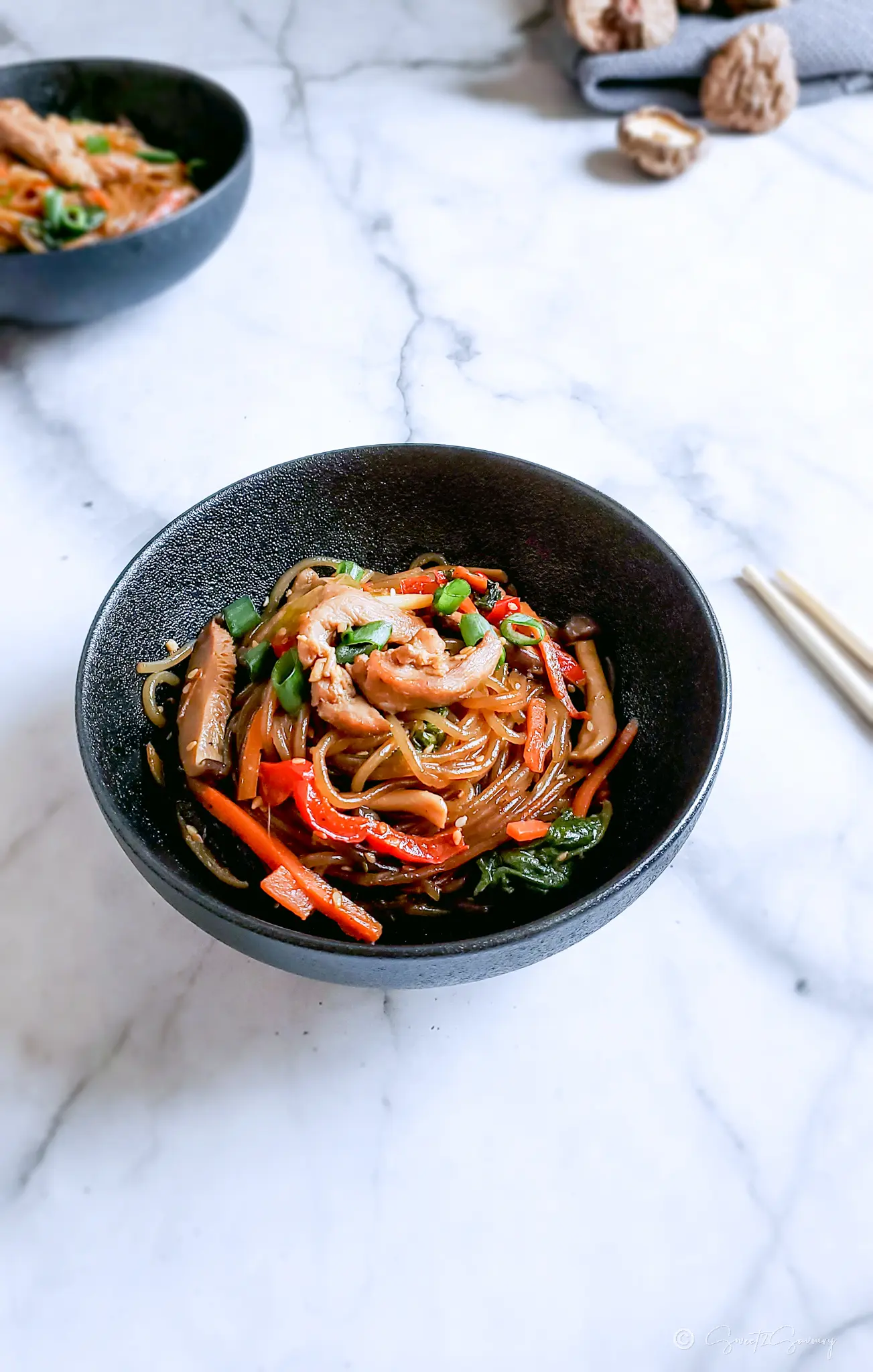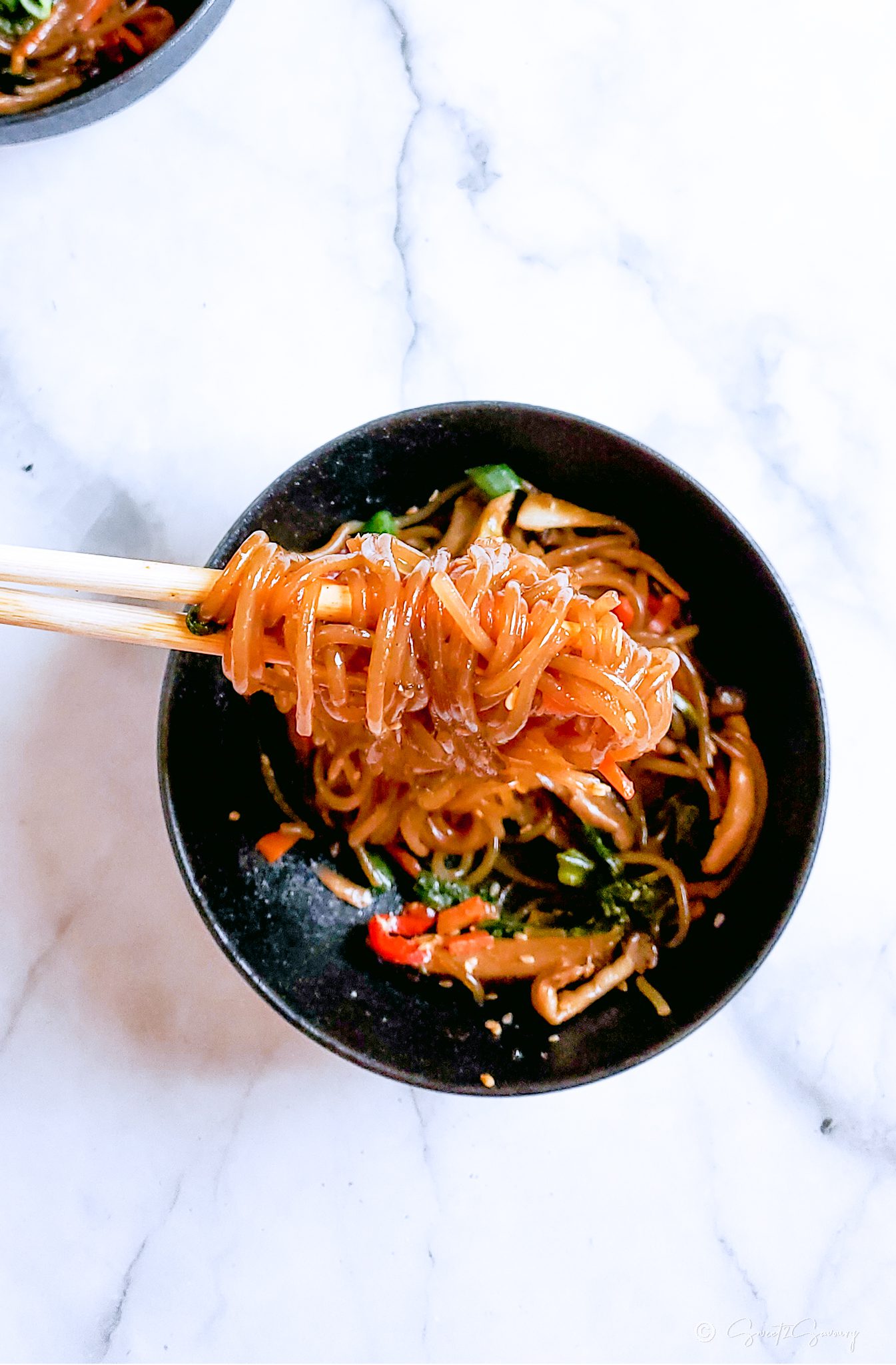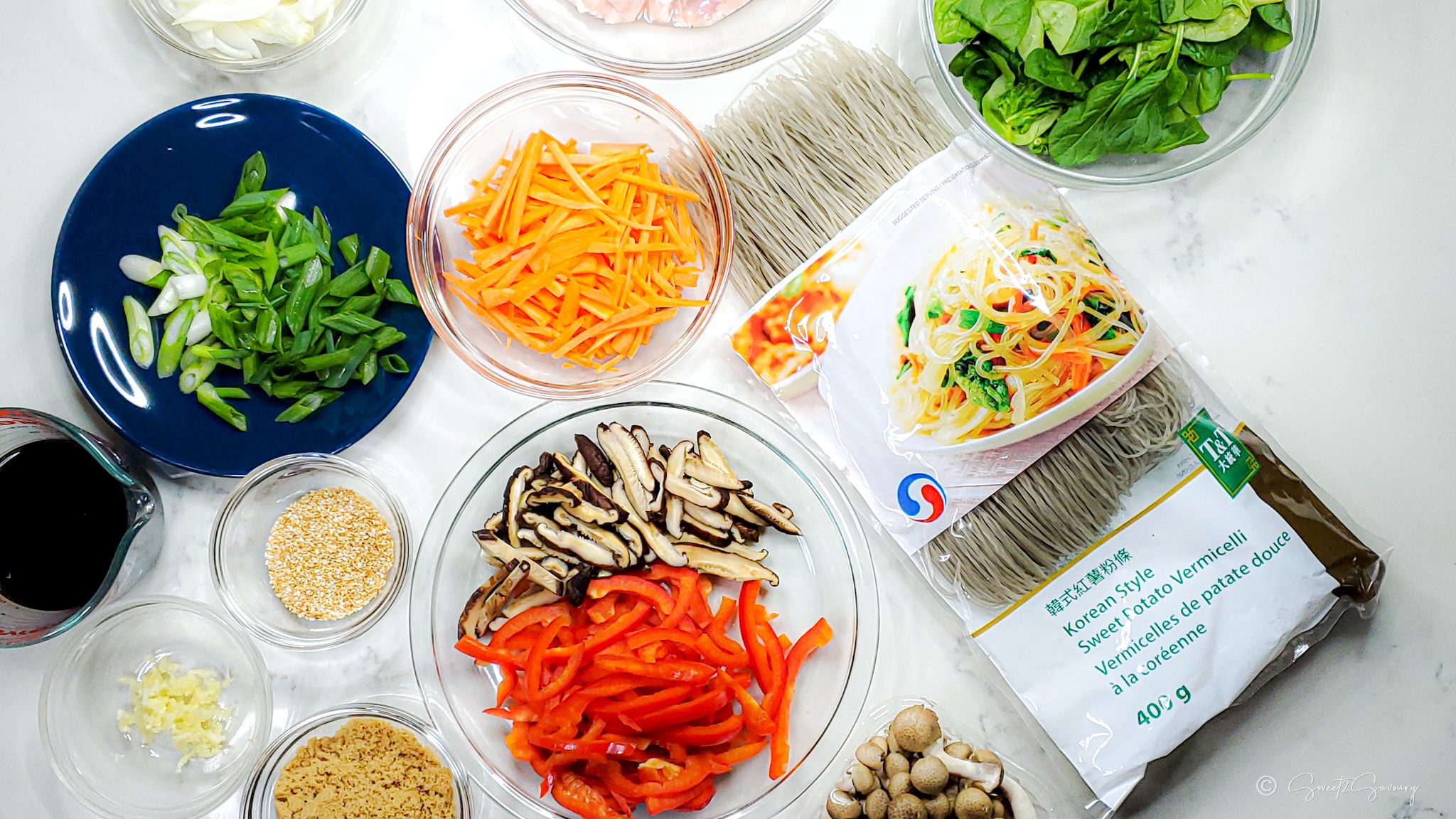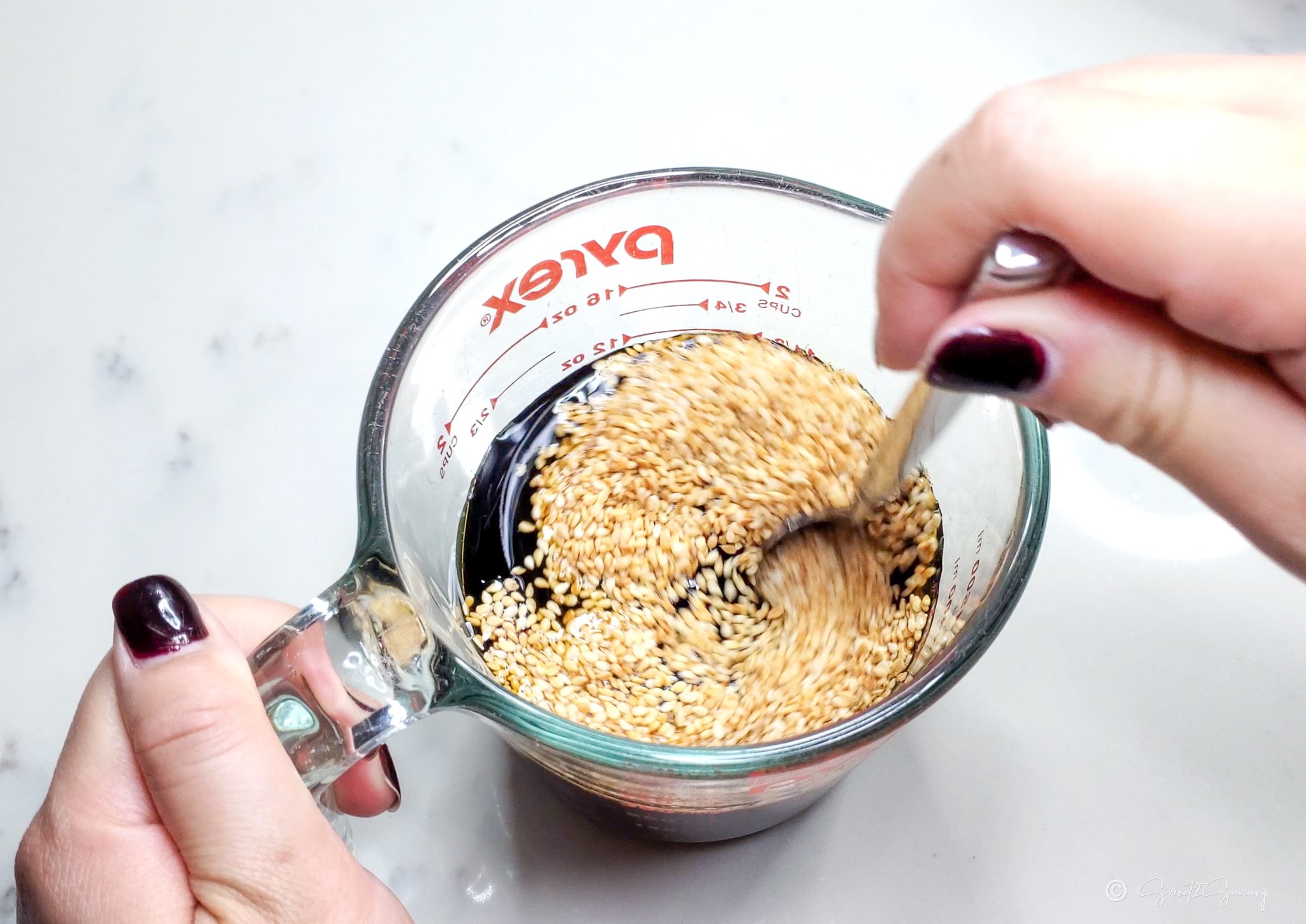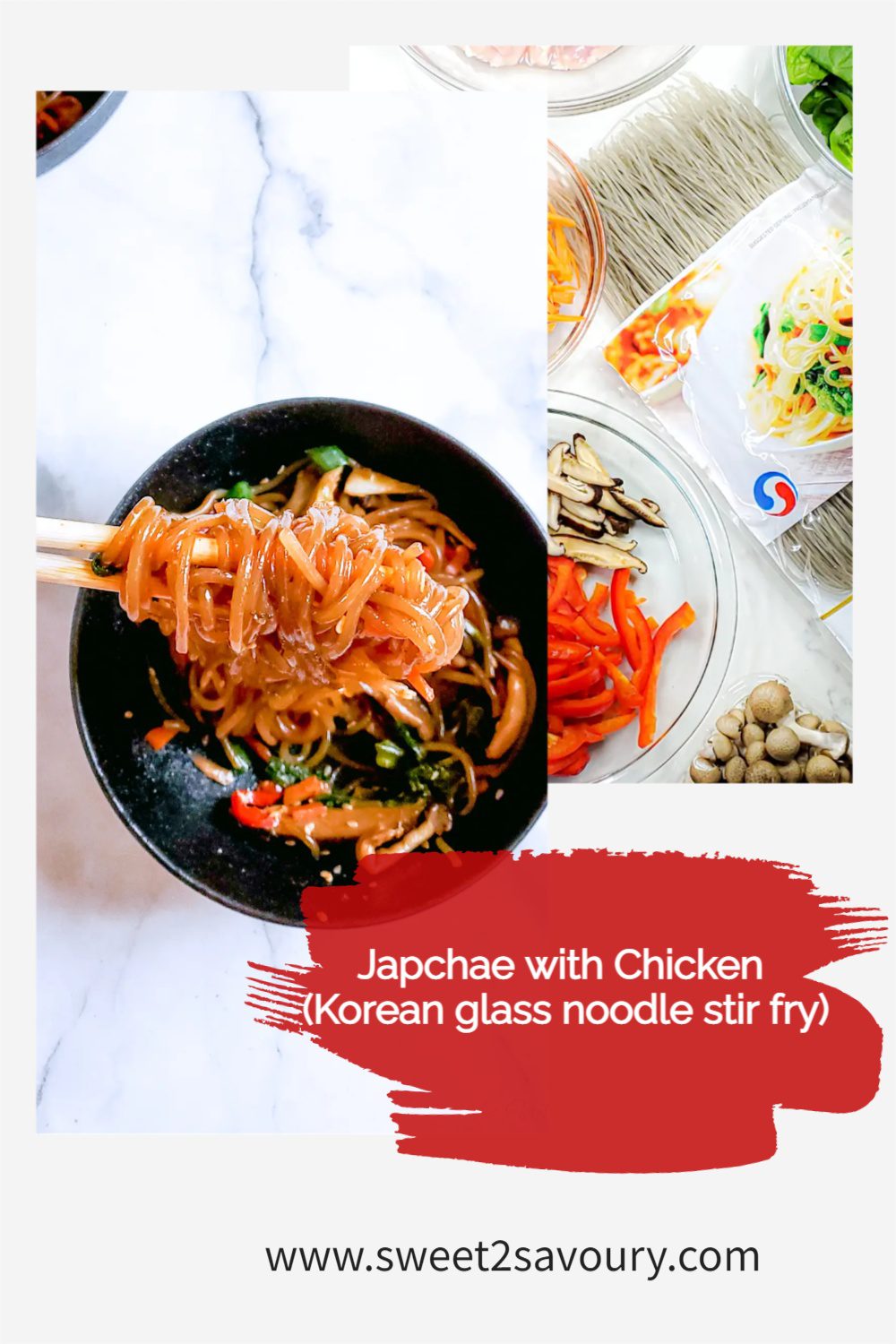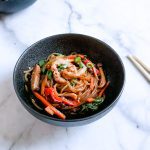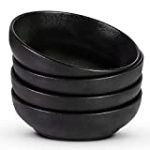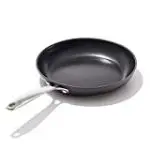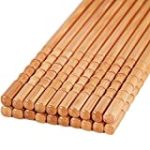Every bite of these chewy flavourful noodles has juicy chicken thigh strips and julienned vegetables cooked in a savoury and sweet sesame-soy sauce. Whether you are enjoying the noodles hot or at room temperature, the springy texture of the sweet potato noodles remains the same and is perfect for any noodle fan!
Korean sweet potato noodles are also known by a few other names such as Dangmyeon, Dangmyun, vermicelli (not to be confused with rice vermicelli), or cellophane noodles. These glass noodles are made with sweet potato starch, making them gluten-free. When cooked, they are chewy and absorb a sauce very well. They also do not tear easily when you pull on them.
The first time I had Japchae was from Costco. Wait, what? Believe it or not, I enjoy shopping at Costco for two reasons; to stock up my pantry and home with items in bulk and to try a new food I have not tried before. Japchae was one of them. It was on sale, and the noodles on the package looked attractive enough for me to try (good job, marketing person…whoever you are). The instructions were simple, heat in the microwave or on the stove in the pan. To my surprise, reheating the noodles from frozen still gave them a bouncy chew in texture! Oh my! I was hooked! From then, it became my mission to create a copy-cat version but with added protein and more vegetables.
If you are looking for other noodle recipes, you can read about them here:
*Good To Know*
- What do Korean sweet potato noodles look like?
The glass noodles have a gray colour but appear more translucent once boiled. They are tasteless when cooked plain but can absorb a lot of flavour and colour when cooked with other spices and condiments. You can buy these dried noodles in a package at your local Asian grocery store in the noodle section. Since they are becoming more popular, you might be able to find them at your local supermarket in the international food aisle as well.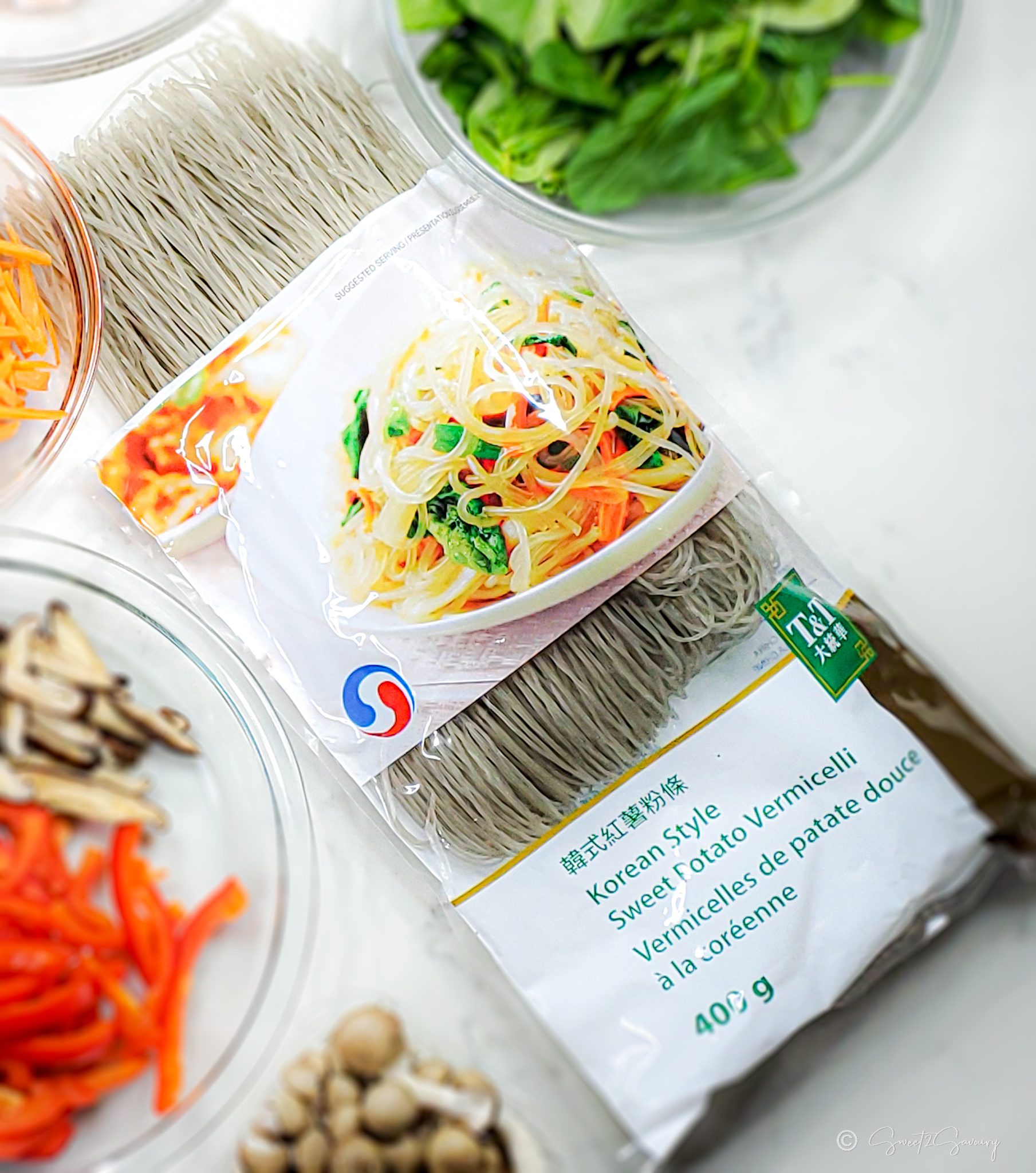
- Can I use other proteins?
You know that my answer will be a resounding yes! Or you can skip the meat entirely to keep it vegan or vegetarian friendly. Instead of chicken thighs, you can use chicken breast, beef, pork, fried egg omelette cut into thin strips, or even fried Tofu for your added protein. The choices are endless! - Which is better, fresh or dehydrated shiitake mushrooms?
Depending on the time of year, you can use fresh shiitake mushrooms if they are in season and easy to find. Your other option is to use dehydrated mushrooms, which can be bought year-round at any Asian supermarket. Be sure to soak dehydrated mushrooms for at least 1 to 2 hours in warm water before you get started on the recipe. Either one is tasty to cook with. Shiitake mushrooms can be pungent. If you are not a fan, you can substitute with other mushrooms such as white, cremini, or portobello.
Ingredients you will need:
For the protein
- boneless chicken thighs (without skin)
- fresh garlic
- green onions
For the sauce & marinade
- soy sauce
- brown sugar
- sesame oil
- toasted sesame seeds
- ground black pepper
For the vegetables
- cooking onion (white or yellow)
- red bell pepper
- carrots
- shiitake mushrooms (from fresh or dehydrated)
- brown beech mushrooms (optional – use any kind you like instead)
- fresh spinach leaves
- kosher or sea salt
- ground black pepper
For the noodles
- Korean sweet potato noodles
Start with making the sauce
It may seem like a lot of sauce initially, but we are dividing it into a marinade for the chicken and the noodles’ finishing sauce. Combine all the sauce ingredients into a large measuring cup (or bowl) and set aside.
Tip
- When cutting root vegetables into thin strips (aka. julienne cuts or match sticks), make sure they have the same length and 1/4-inch thickness to ensure even cooking time.
- If you are omitting meat to make this meal vegetarian-friendly, reduce the sauce in half for the noodles.
Marinate the chicken for 30 minutes
Cut chicken thighs into 1-inch strips and place them into a large mixing bowl. Instead of strips, you can also cut them into 1/2-inch cubes. Add minced garlic to the chicken and pour 1/4 cup of the sesame-soy sauce we made into the bowl. Combine everything with a spatula and cover the bowl with plastic wrap. Marinate chicken in the refrigerator for 30 minutes.
How to cook Japchae
Start with the vegetables
Heat a large nonstick pan on medium-high heat with one tablespoon vegetable oil. Add carrots, mushrooms, and red bell pepper to the pan and cook for 3 minutes while constantly sautéeing with a rubber spatula. Add kosher salt, ground black pepper, and continue to cook for another 3 minutes. Add sliced onion, cook for 2 minutes and finally add spinach. Cook for another 2 minutes or until spinach is wilted. Remove from heat and place cooked vegetables into a large mixing bowl and cover it with plastic wrap to retain the heat.
Cook chicken with the sauce
Keep the heat on medium-high; add marinated chicken to the same pan, pour another 1/4 cup of the sesame-soy sauce and cook chicken for 7 minutes until it is done and the sauce has reduced. Add chopped green onions at the end and stir a few times to mix them into the chicken. If you want to make sure the chicken is fully cooked, the internal temperature of the chicken should read 165ºF (74ºC) on a food thermometer. Combine the cooked chicken with the vegetables in the bowl.
Boil noodles and combine them with everything
Fill 3/4 of a large pot with water and bring it to a boil on high heat with 2 tablespoons of sea salt. Add the dry noodles and cook them for 7 minutes. Drain but do not rinse noodles! Add the cooked noodles to the bowl with chicken and vegetables. Pour in the remaining sesame-soy sauce and combine everything with a tong. At first, it may look a little saucy but the heat of the noodles will absorb most of it.
Japchae can be enjoyed hot or at room temperature. Store leftover noodles in an airtight container in the refrigerator for up to 4 days.
Japchae with Chicken (Korean glass noodle stir fry)
Ingredients
For the sauce
- 1 cup soy sauce
- ¾ cup brown sugar, or white sugar
- 2 Tablespoons sesame oil
- 2 Tablespoons toasted sesame seeds
For the vegetables
- 2 large carrots, peeled & julienned into 1/4-inch thick sticks
- 1 large red bell pepper, rinsed & julienned into 1/4-inch thick sticks
- 5 dehydrated shiitake mushrooms, soaked in warm water for 1 – 2 hours, stems removed & cut into 1/4-inch thick strips
- 5 ounces brown beech mushrooms (optional), or your choice of mushrooms, cut into 1/4-inch thick strips (if needed)
- 1 large yellow or white onion, peeled & cut into thin wedges
- 2 ounces fresh spinach leaves (2 handfuls), rinsed
- 1 teaspoon kosher or sea salt
- ½ teaspoon ground black pepper
For the protein
- 15 ounces boneless, skin-free, chicken thighs (5 pieces), rinsed, patted dry & cut into 1-inch strips
- 3 teaspoons garlic (4 cloves), peeled & minced or pressed
- 2 stalks green onion, trimmed & cut into 2-inch pieces
For the noodles
- 14 ounces Korean sweet potato noodles
INSTRUCTIONS
- In a large measuring cup, combine soy sauce, brown sugar, sesame oil, and toasted sesame seeds.
- In a large bowl with the cut chicken thigh strips, add minced garlic and mix 1/4 cup of the sesame-soy sauce with a spatula into the chicken. Cover the bowl with plastic wrap and refrigerate for 30 minutes to marinate.
- Heat a large nonstick pan on medium-high heat with one tablespoon vegetable oil. Add carrots, mushrooms, and red bell pepper to the pan and cook for 3 minutes while constantly sautéeing with a rubber spatula. Add kosher salt, ground black pepper, and continue to cook for another 3 minutes. Add sliced onion, cook for 2 minutes and finally add spinach. Cook for another 2 minutes or until spinach is wilted. Remove from heat and place cooked vegetables into a large mixing bowl and cover it with plastic wrap to retain the heat.
- Keep the heat on medium-high; add marinated chicken to the same pan, pour another 1/4 cup of the sesame-soy sauce and cook chicken for 7 minutes until it is done and the sauce has reduced. Add chopped green onions at the end and stir a few times to mix them into the chicken. If you want to make sure the chicken is fully cooked, the internal temperature of the chicken should read 165°F (74°C) on a food thermometer. Combine the cooked chicken with the vegetables in the bowl. Cover bowl with plastic wrap again.
- Fill 3/4 of a large pot with water and bring it to a boil on high heat with 2 tablespoons of sea salt. Add the dry noodles and cook them for 7 minutes. Drain but do not rinse noodles! Add the cooked noodles to the bowl with chicken and vegetables. Pour in the remaining sesame-soy sauce and combine everything with a tong. At first, it may look a little saucy but within a few minutes, the heat of the noodles will absorb most of it.
- Japchae can be enjoyed hot or at room temperature. Store leftover noodles in an airtight container in the refrigerator for up to 4 days.
Tips
- When cutting root vegetables into thin strips (aka. julienne cuts or match sticks), make sure they have the same length and 1/4-inch thickness to ensure even cooking time.
- If you are omitting meat to make this meal vegetarian-friendly, reduce the sauce in half for the noodles.

